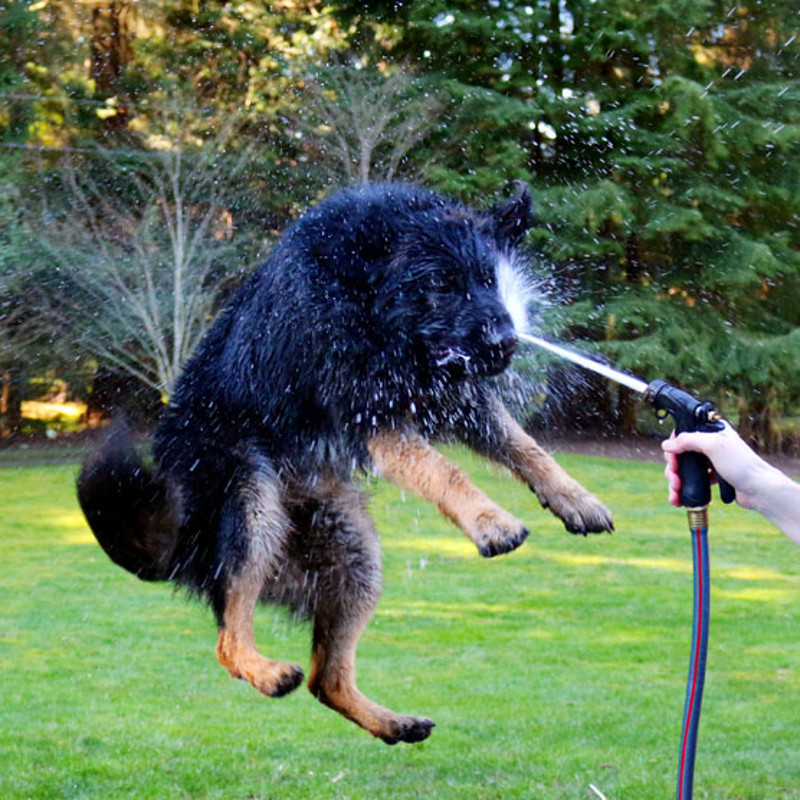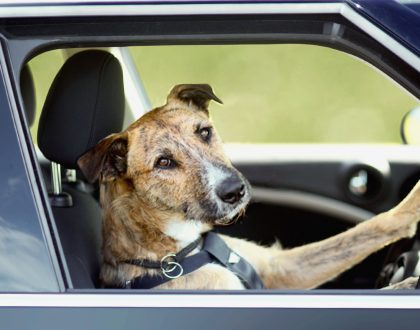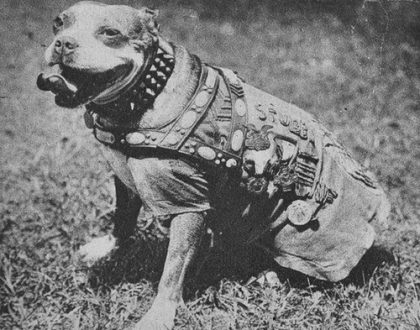Your Pets & Beating the Heat: Being Careful About Staying Cool

Unlike humans, dogs and cats can’t sweat to cool themselves. A common misconception is that cats and dogs sweat through their paws, but, says Kimberly May, a veterinarian with the American Veterinary Medical Association, “any secretions there or from their nose, mouth or tongue are not for sweating; they’re for protection and moisture and are insufficient to cool the blood,” Cats and dogs are able to release heat in other ways, though.
Conduction transfers excess internal heat when animals contact objects cooler than themselves, such as when lying on cool tile. Convection transfers heat away through cold air or water; this occurs when an animal jumps into a pool, is hosed down or has a fan trained on it. Evaporation dissipates heat from within the body when a dog or cat pants. This is their only internal vehicle for releasing stored body heat.
Counterintuitively, fur can help an animal cope in the heat.
“Fur actually insulates the body in cold weather and helps prevent the body from taking on too much heat in warm weather,” says Jones. “Fur acts as a thermal regulator to slow down the process of heat absorption.”
By shedding in hot weather, dogs and cats make their coats more suitable for heat protection instead of warmth. “The thick undercoat that’s needed in order to trap body heat in the cold weather is not required in warm weather. The remaining outer coat is optimal for handling heat as long as it’s not extreme,” explains veterinarian Marty Becker, author of numerous books about dogs and cats.
For this reason, experts agree, it can be a mistake to shave or dramatically trim the coat of a dog or cat in the summer. While it may seem that it would be cooler, it can actually make an animal hotter. In addition, cats and dogs need protection from sunburn and insect bites.
“Dogs have developed their hair coats for a reason. It’s a barrier between the dog’s skin and the sun,” according to Emily Rogell, medical director of the Metropolitan Emergency Animal Clinic in Rockville. “The less heat and sun reach the skin, the less hot the dog will be. I don’t recommend clipping or shaving unless there is a medical reason,” such as a skin condition or terribly matted fur.
Shaving could also contribute to dehydration, says Jones, noting that research has found that “camels in the desert that are shaved, for example, do worse than those with fur, requiring more water evaporation to stay cool.”
Despite these natural mechanisms, Washington summer days can quickly overwhelm pets, even if a human might experience the weather as benign.
But when dogs run around, or are walked or run too long, or when they’re left in the sun, a warm house or a car, they can quickly overheat. Panting or cooling off with water, cool tiles or moving air no longer works to dissipate their rising body heat. And their fur begins to trap heat rather than fend it off, compounding the stress on their body.
“Exercise in the heat is double jeopardy,” says Jones. “The animal’s metabolism is generating internal heat at the same time as it starts having trouble discharging the external heat.” Meanwhile, as the animal tries to maintain its normal body temperature through more panting, it loses water through evaporation, which can cause dehydration.
“Try running in a fur coat for 20 minutes on a warm day, and you’ll have some idea what it’s like for dogs and cats overcome by heat,” says May. “And let’s not forget, dogs don’t know when to stop. They are perpetually willing to keep going despite the heat, just to please us and be with us, and can’t tell us they’re getting too warm. You have to be able to recognize the signs.”
Certain breeds of dogs have particular difficulty in the heat. These include Siberian huskies, Alaskan malamutes, Akitas and chow chows, with coats built for cold weather, and breeds with a pushed-in snout that prevents efficient panting and cooling, such as pugs, bulldogs and Boston terriers, and Himalayan and Persian cats. (In general, cats are less at risk because those that go outside seek shade; vets say most heat problems with cats occur when they’ve been left in a too-warm house or car.)
Any breed of dog or cat that is overweight will have trouble in the heat. “Obese and overweight dogs are particularly heat-sensitive because their weight interferes with thermoregulation — specifically, being able to radiate heat away from their body sufficient to cool down,” according to Allison Sande, an emergency and critical care veterinarian with VCA Veterinary Referral Associates in Gaithersburg.
How can you tell if a dog or cat is in the danger zone regarding heat? It will seem sluggish and perhaps confused. “She will be panting very hard, and her tongue and gums will look bright red,” says May. “If the situation progresses, they may even look gray or purple, which is very bad. She will be weak and uncoordinated.” An animal in heat-induced distress will hyperventilate, drool excessively and show signs of fear. If the body temperature rises above 106 degrees, there can be brain, tissue and organ swelling, with abnormal blood clotting that can damage the kidneys, heart, lungs and brain. Animals eventually collapse and go into a coma, at which point seizure and respiratory arrest develop.
Such problems can escalate fairly quickly.
“A man who happened to be a medical doctor went running with his dog and the dog began panting and becoming lethargic,” says Ashley Hughes, a veterinarian at Friendship Animal Hospital in the District. “He stopped for a while, then started running again with the dog, but this time the dog collapsed and couldn’t get up. He took the dog home and kept a watch on him, but the dog began to get worse. By the time he arrived here for medical care, there was nothing we could do, and the dog died.”
The key to avoiding such an outcome, the vets say, is to always err on the side of caution in hot weather. If you see your animal panting heavily, take it into the shade or a cool room. Run a constant flow of tepid or slightly cool water over its body, especially its head, neck, chest and groin areas. Use your hand to wipe off the water so it carries the heat with it. You can wrap the animal in cool, wet towels, but wring them out and wet them again to keep them cool. Seek immediate medical attention. Spraying with cool water may work for animals with short, sparse hair, but for dogs with lots of hair, the coat can become warm and water-logged and actually increase heat retention.
To prevent heatstroke, vets recommend walking animals only in the coolest parts of the day during the summer, and keeping the walk short. One good rule of thumb for when it’s okay to walk your dog is to put your palms on the sidewalk; if it’s too hot for your palm, it’s too hot for a dog, says Becker. Keep homes cool or well ventilated. And think twice about taking animals on trips and to outdoor events, where it might be hard to prevent them from becoming overheated. And never leave an animal in a parked car on a warm day.
Najar is a freelance writer in Potomac who lives with two cats.
This article reprinted from: The Washington Post
Image source: Public Domain Images
Recommended Posts

Take me for a ride! How to Keep Your Dog (and YOU) Safe in the Car
September 18, 2019

Sergeant Stubby
August 22, 2019


